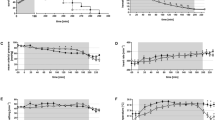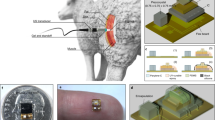Abstract
The effect of nitroglycerin on oxygen (O2) release in the microcirculation was investigated by examining single, unbranched hepatic sinusoids of rats using dual-spot microspectroscopy. Nitroglycerin significantly increased O2 release from erythrocytes flowing in the sinusoids. Differences in O2 saturation of hemoglobin per unit length of the sinusoid were significantly enhanced, while there were no significant changes in erythrocyte velocity, hemoglobin concentration or oxyhemoglobin flow into the sinusoids, or in regional hepatic blood flow measured with a laser tissue blood flow meter. No change was noted for hepatic O2 consumption measured in isolated liver perfused with hemoglobin-free oxygenated buffer. Isosorbide dinitrate showed a similar but slower effect. These findings suggest that nitroglycerin and isosorbide dinitrate enhance O2 release from erythrocytes without significantly increasing tissue blood flow.
This is a preview of subscription content, access via your institution
Access options
Subscribe to this journal
Receive 12 print issues and online access
$209.00 per year
only $17.42 per issue
Buy this article
- Purchase on Springer Link
- Instant access to full article PDF
Prices may be subject to local taxes which are calculated during checkout
Similar content being viewed by others
References
Kosaka, H. & Seiyama, A. Physiological role of nitric oxide as an enhancer of oxygen transfer from erythrocytes to tissue. Biochem. Biophys. Res. Commun. 218, 749–752 (1996).
Seiyama, A., Chen, S.S., Imai, T., Kosaka, H. & Shiga, T. Assessment of rate of O2, release from single hepatic sinusoids of rats. Am. J. Physiol. 267, H944–H951 (1996).
Seiyama, A., Tanaka, S., Kosaka, H. & Shiga, T. O2 transfer from single microvessels to acinar cells in secretin-stimulated pancreas of rats. Am. J. Physiol 270, H1704–H1711 (1996).
Seiyama, A., Kosaka, H. & Shiga, T. Effect of ACh and calmodulin inhibitor on O2, transfer from exocrine pancreatic microvessels of rats. Am. J. Physiol. 271, H1–H7 (1996).
Chen, S.S. et al. Measurement of redox states of mitochondrial cytochrome aa3 in regions of liver lobule by reflectance microspectroscopy. Am. J. Physiol. 264, G375–G382 (1993).
Wittenberg, J.B. The molecular mechanism of hemoglobin-facilitated oxygen diffusion. J. Biol. Chem. 241, 104–114 (1966).
Douglas, C.G., Haldan, J.S. & Haldan, J.B.S. The laws of combination of haemoglobin with carbon monoxide and oxygen. J. Physiol. (London) 44, 275–304 (1912).
Okada, Y., Tyuma, I., Ueda, Y. & Sugimoto, T. Effect of carbon monoxide on equilibrium between O2 and hemoglobin. Am. J. Physiol. 230, 471–475 (1976).
Kurz, M.A., Boyer, T.D., Whalen, R., Peterson, T.E. & Harrison, D.G. Nitroglycerin metabolism in vascular tissue: Role of glutathione S-transferases and relationship between NO and NO2− formation. Biochem. J. 292, 545–550 (1993).
Kosaka, H. et al. Direct proof of nitric oxide formation from a nitrovasodilator metabolised by erythrocytes. Biochem. Biophys. Res. Commun. 204, 1055–1060 (1994).
Kosaka, H. et al. ESR spectral transition by arteriovenous cycle in nitric oxide hemo globin of cytokine-treated rats. Am. J. Physiol. 266, C1400–C1405 (1994).
Kosaka, H. & Shiga, T. Detection of nitric oxide by electron spin resonance using hemoglobin. in Methods in Nitric Oxide Research (eds. Feelisch, M. & Stamler, J. S.) 373–381 (Wiley, West Sussex, England, (1996).
Khandelwal, S.R. et al. Enhanced oxygenation in vivo by allosteric inhibitors of hemoglobin saturation. Am. J. Physiol. 265, H1450–1453 (1993).
Hille, R., Olson, J.S. & Palmer, G. Spectral transitions of nitrosyl hemes during lig-and binding to hemoglobin. J Biol. Chem. 254, 12110–12120 (1979).
Fujii, M., Hori, H., Miazaki, G., Morimoto, H. & Yonetani, T. The porphyrin-iron hybrid hemoglobins. Absence of the Fe-His bonds in one type of subunits favors a deoxy-like structure with low oxygen affinity. J.Biol. Chem. 268, 15386–15393 (1993).
Jia L., Bonaventura, J. & Stamler, J.S. S-Nitrosohaemoglobin: A dynamic activity of blood involved in vascular control. Nature 380, 221–226 (1996).
Wayland, H. & Johnson, P.C. Erythrocyte velocity measurement in microvessels by a two-slit photometric method. J. Appl. Physiol. 22, 333–337 (1967).
Schmid-Schönnbein, G.W. & Zweifach, B.W. RBC velocity profile in arterioles and venules of the rabbit omentum. Microvasc. Res. 10, 153–164 (1975).
Lipowsky, H.H. & Zweifach, B.W. Application of the two-slit photometric technique to the measurement of microvascular volumetric flow rates. Microvasc. Res. 15 93–101 (1978).
Author information
Authors and Affiliations
Rights and permissions
About this article
Cite this article
Kosaka, H., Seiyama, A. Elevation of oxygen release by nitroglycerin without an increase in blood flow in the hepatic microcirculation. Nat Med 3, 456–459 (1997). https://doi.org/10.1038/nm0497-456
Received:
Accepted:
Issue Date:
DOI: https://doi.org/10.1038/nm0497-456



